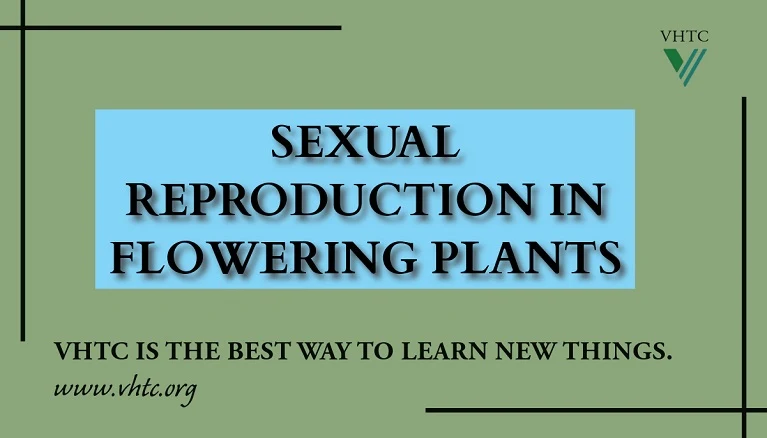Flowering plants, also known as angiosperms, rely on a fascinating and intricate process for sexual reproduction. This method involves the flower, a specialized structure that not only holds aesthetic beauty but also plays a vital role in plant procreation. Let's delve into the wonders of sexual reproduction in flowering plants:
Key Points:
➡️The Flower as the Reproductive Unit: Unlike other plant parts, flowers are specifically designed for sexual reproduction. They house both male and female reproductive organs, creating a self-contained system for generating offspring.
➡️Key Players: Stamen and Pistil: The flower's male reproductive organs are called stamens. Each stamen consists of a filament, a stalk-like structure, and an anther, a sac-like container that produces pollen grains. These pollen grains contain the male gametes (sperm cells) of the plant. The female reproductive organ is the pistil, which is typically located in the center of the flower. The pistil is made up of three parts: the stigma, a receptive surface that receives pollen; the style, a tube-like structure that connects the stigma to the ovary; and the ovary, which contains one or more ovules (future seeds).
➡️The Magic of Pollination: Pollination is the crucial first step in sexual reproduction. It involves the transfer of pollen grains from the anther of a stamen to the stigma of a pistil. This transfer can happen in two ways: self-pollination, where pollen from the same flower fertilizes the ovules, or cross-pollination, where pollen from a different flower of the same species fertilizes the ovules. Pollination is often facilitated by wind, insects, birds, and other animals attracted by the flower's color, fragrance, or nectar.
➡️Fertilization and Seed Development: Once pollen lands on a receptive stigma, it germinates, forming a pollen tube that grows down the style towards the ovary. Inside the ovary, the pollen tube releases sperm cells, which fuse with the egg cells within the ovules. This fusion of sperm and egg, known as fertilization, triggers the development of an embryo within each ovule. The ovary matures into a fruit, and the ovules develop into seeds containing the plant's next generation.
➡️Advantages of Sexual Reproduction: Sexual reproduction in flowering plants offers several advantages. It allows for genetic variation among offspring, which can increase their chances of survival in a changing environment. Additionally, the production of fruits can attract animals who disperse seeds, helping plants colonize new habitats.
Sexual Reproduction in Flowering Plants - CLASS 12 NOTES


![Sexual Reproduction in Flowering Plants - Biology Short Handwritten Notes [PDF]📚 Sexual Reproduction in Flowering Plants - Biology Short Handwritten Notes [PDF]📚](https://blogger.googleusercontent.com/img/b/R29vZ2xl/AVvXsEjD9LZbCtUXeGjo4eT_i6f6lcbghoCDjdWKXZPr0PkLEOCKRqWdhpe8XUlKdOVyUena-sO0f4k5RviDO4MLWx-XmD6zG7EdUfwgNDwpmN6qANYjLsENBlYZx-9luaNQD8q2-95RoWklYCD3mnT4KAr9JjTWFbCNCia8N5ceGVt9jkvSZZzdB5a9JdX1CDM/s16000-rw/Sexual%20Reproduction%20in%20Flowering%20Plants%20-%20Biology%20Short%20Handwritten%20Notes%201.jpeg)

![Sexual Reproduction in Flowering Plants - Biology Short Handwritten Notes [PDF]📚 Sexual Reproduction in Flowering Plants - Biology Short Handwritten Notes [PDF]📚](https://blogger.googleusercontent.com/img/b/R29vZ2xl/AVvXsEg7gQ1ivIbHF00-wg44ddmjwMIoXqhczUhKDF9tdQvzgny54UxvD66sazLcrpSfnfG2MMtYFALE8wSEMtmTC47NWMHfoRmKqlijCcB5BKkkKX2m8yQo1qzJcap4BZgy4KYqhgdYezUV-urSdkXo1I12rbntHbwxFet7TtiLATRCy1u6xErbdXJBgDnr82M/s16000-rw/Sexual%20Reproduction%20in%20Flowering%20Plants%20-%20Biology%20Short%20Handwritten%20Notes.jpeg)
%20-images-1.jpg)
%20-images-2.jpg)
%20-images-3.jpg)
%20-images-4.jpg)
%20-images-5.jpg)
%20-images-6.jpg)
%20-images-7.jpg)
%20-images-8.jpg)
%20-images-9.jpg)
%20-images-10.jpg)
%20-images-11.jpg)
%20-images-12.jpg)
